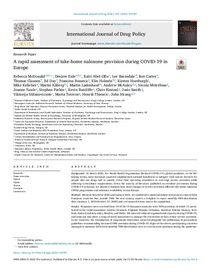Bienvenidos al Repositorio Digital de la UPF
A rapid assessment of take-home naloxone provision during COVID-19 in Europe
JavaScript is disabled for your browser. Some features of this site may not work without it.
Mostrar el registro sencillo del ítem
| dc.contributor.author | McDonald, Rebecca |
| dc.contributor.author | Fonseca Casals, Francina, 1972- |
| dc.contributor.author | Strang, John |
| dc.date.accessioned | 2023-01-30T07:47:42Z |
| dc.date.available | 2023-01-30T07:47:42Z |
| dc.date.issued | 2022 |
| dc.identifier.citation | McDonald R, Eide D, Abel-Ollo K, Barnsdale L, Carter B, Clausen T et al. A rapid assessment of take-home naloxone provision during COVID-19 in Europe. Int J Drug Policy. 2022 Sep;107:103787. DOI: 10.1016/j.drugpo.2022.103787 |
| dc.identifier.issn | 0955-3959 |
| dc.identifier.uri | http://hdl.handle.net/10230/55473 |
| dc.description.abstract | Background: In March 2020, the World Health Organization declared COVID-19 a global pandemic. In the following weeks, most European countries implemented national lockdowns to mitigate viral spread. Services for people who use drugs had to quickly revise their operating procedures to rearrange service provision while adhering to lockdown requirements. Given the scarcity of literature published on overdose prevention during COVID-19 in Europe, we aimed to examine how these changes to service provision affected take-home naloxone (THN) programmes and naloxone availability across Europe. Methods: Between November 2020 and January 2021, we conducted a rapid assessment with country experts from European countries that provide THN. We sent country experts a template to report monthly THN distribution data (January 1, 2019-October 31, 2020) and a structured 6-item survey for completion. Results: Responses were received from 14 of the 15 European countries with THN provision of which 11 participated in the rapid assessment: Austria, Denmark, England, Estonia, Lithuania, Northern Ireland, Norway, Scotland, Spain (Catalonia only), Sweden, and Wales. All reported reduced organisational capacity during COVID-19, and some put into place a range of novel approaches to manage the restrictions on face-to-face service provision. In six countries, the introduction of programme innovation occurred alongside the publication of government guidelines recommending increased THN provision during COVID-19. Eight of the eleven participating countries managed to maintain 2019-level monthly THN distribution rates or even increase provision during the pandemic. Conclusion: Through programme innovation supported by public guidelines, many European THN programmes managed to ensure stable or even increased THN provision during the pandemic, despite social distancing and stay-at-home orders affecting client mobility. |
| dc.format.mimetype | application/pdf |
| dc.language.iso | eng |
| dc.publisher | Elsevier |
| dc.relation.ispartof | Int J Drug Policy. 2022 Sep;107:103787 |
| dc.rights | © 2022 The Author(s). Published by Elsevier B.V. This is an open access article under the CC BY license (http://creativecommons.org/licenses/by/4.0/). |
| dc.rights.uri | http://creativecommons.org/licenses/by/4.0/ |
| dc.title | A rapid assessment of take-home naloxone provision during COVID-19 in Europe |
| dc.type | info:eu-repo/semantics/article |
| dc.identifier.doi | http://dx.doi.org/10.1016/j.drugpo.2022.103787 |
| dc.subject.keyword | Coronavirus |
| dc.subject.keyword | Harm reduction |
| dc.subject.keyword | Heroin |
| dc.subject.keyword | Opiate |
| dc.subject.keyword | Opioid |
| dc.subject.keyword | Overdose |
| dc.rights.accessRights | info:eu-repo/semantics/openAccess |
| dc.type.version | info:eu-repo/semantics/publishedVersion |


